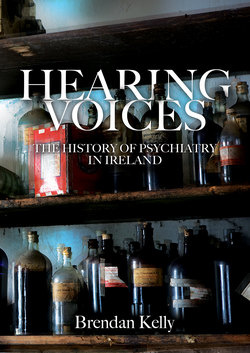Читать книгу Hearing Voices - Brendan Kelly - Страница 8
На сайте Литреса книга снята с продажи.
ОглавлениеFOREWORD
Of the many national histories of psychiatry, Brendan Kelly’s well-researched and compellingly written history of Irish psychiatry leads the pack. This is the first comprehensive history of psychiatry in Ireland.
Kelly, who is an historian as well as the Professor of Psychiatry at Trinity College, Dublin, shares the historian’s preference for primary sources, often unpublished, in order to let the people of the time speak for themselves. And here, in a story that begins in 1745 with author Jonathan Swift providing in his will for the establishment of a proper hospital for the mentally ill, the psychiatrists of the day as well as the patients find their voices heard loudly and clearly.
Kelly’s main theme is that ‘the asylums were primarily social creations, reflecting social and political change far more than they ever reflected changes in the practice of medicine and psychiatry’. The story is driven for the most part by changes in the real world, such as the Famine, rather than by internal motors such as the introduction of new concepts or medications – though Kelly gives the internalist moments their full due.
This is not ‘antipsychiatry’ history at all, in which we learn that there is no such thing as mental illness and that the physicians were mainly intent upon increasing their ‘power’. Kelly, himself a senior figure, respects the magnitude of the therapeutic power that psychiatry often brings to bear, and ventilates fully the sufferings of the patients in the hope that future patients who encounter this work might bear away some measure of encouragement.
Ireland in the nineteenth century groaned under often unimaginable poverty, and Kelly notes that, ‘the asylums functioned as a vast, unwieldy social welfare system for patients and possibly some staff’. Before the 1960s, in other words, psychological medicine was centred in asylums, and this, says Kelly, left an indelible stain on Irish psychiatry as the psychiatry of confinement.
The central issue in the Irish history, Kelly argues, is not why the rate of mental illness was higher in Ireland than elsewhere (Kelly definitively shows it was not). Rather, the big question is why Ireland’s asylums were larger in size – and slower to decrease in size – than elsewhere. The answer lies in a society that has ‘an apparently insatiable hunger for institutionalization’. This would be an Irish theme, there was no comparable hunger in Italy, for example.
Yet Irish psychiatry reflects other themes that are global in scope. It was true in many lands that admission to an asylum in the nineteenth century could be a death warrant, because tuberculosis (TB) was endemic and spread easily from patient to patient. Kelly finds that 16 per cent of the Irish general population died of TB, 25 per cent of the asylum population.
Everywhere in the nineteenth century, ‘insanity’ was thought to be increasing. Yet the consensus among historians of other countries was that it was not. Kelly finds an increase unlikely for Ireland as well. What did change was the ‘presentation’, or ascertainment, of mental disorder, which shifted from what we now call ‘intellectual disability’ (formerly, ‘idiots’) to psychotic disorder (formerly, ‘lunatics’). Moreover, the Famine may have tipped mentally precarious individuals into outright insanity, thus increasing the rate for a short time. What makes the notion of a long-term increase in mental illness unlikely is that the major disorders in psychiatry are heavily influenced by genetics, and genetic factors are unlikely to change much over time. Was there more ‘stress’ in modern urban life than previously? Every generation lives with the idea that it is more subject to stress than the previous generation. This belief is likely a constant in the human condition.
Were more Irish in fact mentally ill than elsewhere? Kelly says that in 1901 the Irish rate of insanity in the population outside of institutions was 11 per 100,000, which on a comparative basis is probably quite low (comparing these international statistics is like quicksand). The ‘Mad Irishman’ was thus an unjust stereotype, an urban myth, not a firm national reality.
As we approach the present, asylum stays become much shorter. One reason is the introduction of the antipsychotic drug chlorpromazine (Largactil) in 1954 and its successors. The antipsychotics do not abolish hallucinations and delusions entirely but make it possible for patients to tolerate their disorders with less anxiety and agitation, and thus to be able to cope once again with life outside the asylum.
Yes, of course, this is a social plus. Yet one advantage of the traditional long stays was the ability of the staff to ensure that the patient was in fact quite well before discharging him or her. It is a historical reality that suicides post-discharge today are much higher than they were in the nineteenth century – and this despite the introduction of psychopharmacological agents that supposedly reduce suicidality. So, before we pat ourselves too smugly on the back for the wonderful progress we’ve made in reducing ‘institutionalisation’, let us keep in mind that these old, and today much maligned, asylums did serve a social purpose that we have been unable to replace.
This, therefore, is the story of Irish psychiatry, told by a scholar who is both a historian and a clinician, and has both skill sets. The book is an exhaustively researched look at the past; it concludes with a speculative glance at the future of Irish psychiatry, and is well worth the price of admission for those interested in Irish mental health issues in the present.
Prof. Dr Edward Shorter, PhD FRSC
Jason A. Hannah Professor of the History of
Medicine and Professor of Psychiatry
Faculty of Medicine, University of Toronto
